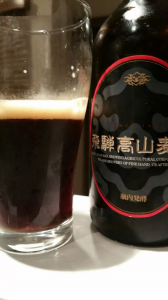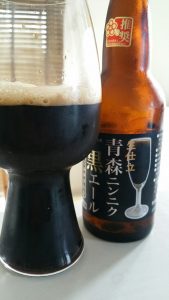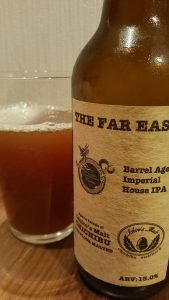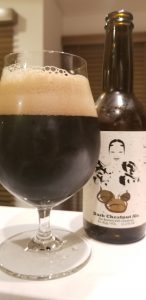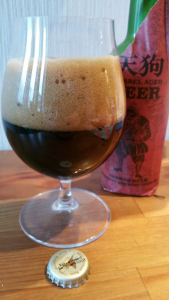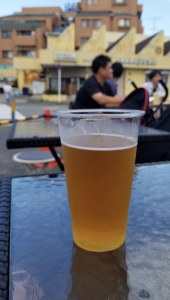It’s been a very quick five years since the inception of BeerTengoku – the story has been told numerous times about how the site came about: a drunken conversation about the lack of regular coverage of Japanese craft beer in an American craft beer bar. Since then, we’ve grown so much – 2,000 articles that started off with beers, before moving onto bars, interviews, drunken ramblings, craft beer maps, and other random things. We’ve had some of the best Japan has to offer, but we’ve also had some of the worst too. We put out a question about what people would like to see for our fifth anniversary, and the main idea was our best / worst five beers, along with limited editions.
Beer is subjective – what we’ve liked may not be what you’ve enjoyed or may have even liked – that’s the beauty of the multi-coloured liquid – it can inspire conversations about flavours, or help people to learn about complex hop combinations and the caramelisation point of certain malts, or perhaps the differences between a pilsner from Czech Republic, Germany, or the USA. When it came to deciding this list, it was based on a few factors:
- How much we liked the beer – of course this is subjective and may change but these are the beers we really liked.
- How likely we are to order it again – it could be a good beer, but does anyone want 6 pint of barleywine?
- After 1 to 5 years, how has it stood the test of time – a beer we had 4 years ago may have had its recipe changed.
BeerTengoku’s Best Five Beers – All-Year Round
For this section, we’re going to look at beers that are available all-year round in either bottles, cans, or on tap. Some of these started off as limited editions but made the successful step up to becoming regular beers due to their popularity. We’d love to say we had some influence over the drinkers in Japan, but we’re too modest for that. This isn’t in any order either – they are five beers that we’ve had multiple times and enjoyed them that when we see them on a menu of blandness, we’ll jump to these. It would be easier to make a top ten but then it is always easier when you have more options to choose from.
What was meant to be a one-off limited edition beer has grown to be one of Shiga Kogen’s most popular, and best, offerings. It’s been so popular that Tamamura Honten, makes of the Shiga Kogen range of beers, even gave the bottle label a redesign, eschewing the staid limited edition / special labels, and also the regular bold Pantone-like labels for something with a bit of class. It’s dry, American hopped body is great on a hot summer’s day when you want something crisp and refreshing, and pays a good homage to the scene that helped mold some of Japan’s past, and also future, efforts into craft beer. While it’s at the lower end of the alcohol levels for an imperial / double IPA, it’s lower ABV also means you can drink a few more of them in a session without getting too drunk.
Review: Shiga Kogen No 10 Anniversary IPA by Tamamura Honten
Who’d have thought that a small microbrewery located in the valleys and hills of Gifu could produce an amazing beer, let alone an amazing Belgian strong ale. The first time we had this was at Thrash Zone Yokohama where we had first come across it. A 10% Belgian strong ale in a bar that heavily leans on thrash metal as well as bold, brash beers sounds like a strange combination but we tried it, fell in love with it, and were delighted to find out that Hidatakayama Karumina was also a part of a regular lineup from Hidatakayama. The bottled version can be aged, and is well worth doing – it’s plummy flavours becoming more present over the years, and the spices just tailoring off a little bit to make Hidatakayama Karumina one of the best beers both for aging and for us in Japan.
Review: Hidatakayama Karumina by Hida Takayama Beer
It was always going to be a tough call to decide on a hefeweizen – it’s a style of beer that in the past has been advertised towards female drinkers; however, we love a pint or two of a well made hefeweizen on a hot summer’s day. Fujizakura Heights Weizen is spot on for the style and does everything a hefeweizen is supposed to do – banana and cloves, big aroma, nice yeasty notes, and refreshing. We’ve had it fresh from the brewery, and also in bottles, and we’re going to carry on ordering it when we see it. Fujizakura Heights Weizen is easily found across Japan, though one of the big disappointments about the beer is the packaging as over time, Fujizakura Heights went from selling the beer in 500ml bottles down to 330ml bottles, making it more in line with other breweries in Japan.
Review: Fujizakura Heights Weizen by Fuji Kanko Kaihatsu
Kyoto Brewing Company, along with Yorocco Beer, brought a refreshed view on Belgian beers in Japan, moving away from the krieks, lambics, and sours that seems to proliferate the domestic market. Not to say there’s anything wrong with those beers, but there were plenty of styles that domestic drinkers had yet to fully embrace. Kyoto Brewing Ichigo Ichie was first had on tap at a Baird Beer bar, and soon became one of our favourites. It’s crisp dry body, and yeasty body, resembled a Saison Dupont so much so that it quickly sold out whenever it was on tap somewhere. Kyoto Brewing Company didn’t have the space to bottle their beers initially, but thankfully they soon started to bottle one of their most popular beers, though it is still hard to find in bottles outside of Kyoto. Here’s hoping that changes soon.
Review: Kyoto Brewing Ichigo Ichie by Kyoto Brewing Company
What does it take to make one of, if not the, best pilsners in Japan? A Czech brewer to move to the northern most part of Ishikawa, on the coast of the Japan sea that gets dumped on with some of the highest levels of rain and snow throughout the year. Once you’ve got that combination, then you can make the Nihonkai Pilsner – a deliciously crisp beer that is everything that a pilsner should be, and that includes the slight bitter flourish at the end of drinking. The bottled version is as good as the tap version, though we do recommend drinking it as fresh as you can. Like other beers on this list, once we’ve seen it on the menu, it has often been too late as other drinkers have noticed it and gone and ordered it to. Beat the crowd and buy it. The disappointing thing about the beer now is that the head brewer has moved on but the beer still tastes damned good – just don’t go changing the recipe now!
Review: Nihonkai Club Pilsner by Nihonkai Club
BeerTengoku’s Worst Five Beers
What would a list of our best five beers be without a list of what our worst five beers would be. Some of these could be obvious, others maybe a little left-field, but they all share a couple of common points – beers so bad that you know you can’t finish it off and would not give it to someone else, or they have just been so undrinkable that they have been left in the glass in the bar to be taken away. The famed beer writer, Michael Jackson, was once asked about his opinions on bad beer:
“If I can find something good to say about a beer, I do. Any merit or unusual aspect is, I believe, of interest to my readers…. Nor since I have the whole world from which to choose, can I be comprehensive. If I despise a beer, why find room for it? This poses a problem only when a beer is too big to ignore.” Micheal Jackson
We’re fools at times for drinking and reviewing (almost) everything as we don’t want people to waste their money on beers, but sometimes beers have been so bad we’ve had to write about them to let people know. Here’s our worst five beers in Japan – some breweries could take up the top five spots themselves, but that would not be fair. Perhaps these beers have gotten better over time but we’re loathed to try them again – once bitten, twice shy.
-
Abashiri Okhotsk Blue Ryuhyo Draft (Fruit / Spiced Beer)
The beer that started off BeerTengoku has been controversial to say the least – it has been one of our most popular reviews on the site, in spite of us trying to bury the review with hundreds of beer reviews, it still ranks as one of the top year upon year. It’s provoked ire among readers too, with some extolling its virtues, while others being not so nice and being argumentative and prickish. With its bright blue colour, it’s quirky and unusual; however, those some lurid colours that once made it unique are now more common with sours, NE-IPAs, fruited beers producing ever bright and lurid colours. What hasn’t changed is that Abashiri Okhotsk Blue Ryuhyo is still a disgusting beer and I can’t bring myself to sip it, let alone drink it. I’d rather drink a can of Red Bull than drink this stuff – and I hate Red Bull. PS. Joe – go fuck yourself.
Review: Abashiri Okhotsk Blue Ryuhyo Draft by Abashiri Beer
Ji-beer gave Japanese beers a bad reputation in the 90s, and for good reason. Some of them were undrinkable swill and people quickly came to their senses about it. Bottles of beer that resembled a murky mess, with tie ins with local farmers and producers. One of the cachets of Ji-beer is that it is has to be tied into the local community so brewers found local produce – fruits, herbs, and spices – to place into their beer. But garlic? There’s a reason why it has been done only once and we quickly found out why. A black turbid mess of a beer that quickly joined the drain club. With its fresh garlic and also garlic flavouring, someone was really trying to promote the local garlic scene – if there was one? The residing memory of Aomori Garlic Black Ale was it sitting in the toilet and Joe laughing about how happy he was he didn’t have to drink it.
Review: Aomori Garlic Black Ale by Aomori Ji-beer
- Fukagawa Monzen Nakacho (Pilsner)
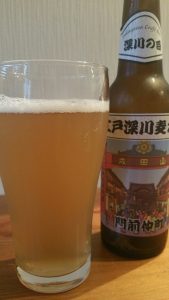 Lagers are ten a plenty in Japan – it is the most popular style of beer in the macro market, but at the beginning of the craft beer boom, breweries had German brewers who knew how to make pilsners, weizens, and alts. Pilsners were then the most popular style of craft beer, but your beer has to be damned good to beat the macro pilsners who have refined their recipes over the years. It’s a style of beer that, when done well, shows off a brewer’s ability to get the best out of their yeast. Done badly, and they become butter bombs loaded with sulphides – something nobody wants. Virgo Beer are well known in the craft beer community – somehow they have survived when they should have fallen by the wayside, but with Fukagawa Monzen Nakacho, they excelled themselves. The whole range (the Edo Kameido Red and Fukagawa Kuro Eidaibashi and everything else from Virgo) could have taken three spots on this list alone but Fukagawa Monzen Nakacho gets it for being just a terrible waste of money.
Lagers are ten a plenty in Japan – it is the most popular style of beer in the macro market, but at the beginning of the craft beer boom, breweries had German brewers who knew how to make pilsners, weizens, and alts. Pilsners were then the most popular style of craft beer, but your beer has to be damned good to beat the macro pilsners who have refined their recipes over the years. It’s a style of beer that, when done well, shows off a brewer’s ability to get the best out of their yeast. Done badly, and they become butter bombs loaded with sulphides – something nobody wants. Virgo Beer are well known in the craft beer community – somehow they have survived when they should have fallen by the wayside, but with Fukagawa Monzen Nakacho, they excelled themselves. The whole range (the Edo Kameido Red and Fukagawa Kuro Eidaibashi and everything else from Virgo) could have taken three spots on this list alone but Fukagawa Monzen Nakacho gets it for being just a terrible waste of money.
Review: Fukagawa Monzen Nakacho by Virgo Beer
- Sakura Mayflower IPA (English IPA)
 During the late 2000’s and early 2010’s, the American influence on craft beer Japan become more prevalent and the IPA soon replaced the pilsner as king of craft beer – everyone was making them and if you weren’t, then you were missing out a growing portion of the market. IPAs are often thought of as hop bombs – load up the hops and boom, you’ve got an IPA. However, they complex hop combinations and the interactions between the hops means that a balance is needed. There’s no point in making an IPA with 100+ IBUs if it tastes like battery acid, while there’s no point in loading up the lemon flavours just to show off how much lemon is in a hop. A bad base can also cause problems and that was the case with Sakura Mayflower IPA – off-flavours galore with some paint-stripper like alcohol taste to it.
During the late 2000’s and early 2010’s, the American influence on craft beer Japan become more prevalent and the IPA soon replaced the pilsner as king of craft beer – everyone was making them and if you weren’t, then you were missing out a growing portion of the market. IPAs are often thought of as hop bombs – load up the hops and boom, you’ve got an IPA. However, they complex hop combinations and the interactions between the hops means that a balance is needed. There’s no point in making an IPA with 100+ IBUs if it tastes like battery acid, while there’s no point in loading up the lemon flavours just to show off how much lemon is in a hop. A bad base can also cause problems and that was the case with Sakura Mayflower IPA – off-flavours galore with some paint-stripper like alcohol taste to it.
Review: Sakura Mayflower IPA by Sakura Brewery
- Niigata Sparkling Mango (Fruit / Spiced Beer)
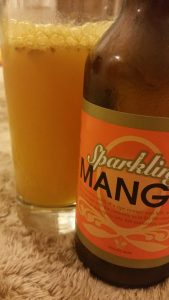
Like Virgo Beer, Niigata Beer could easily fill up a top five list by themselves, but with Niigata Sparkling Mango they truly pushed the boat out for beer drinkers in making a terrible beer. The evidence is in the picture with the brown bits, with what I assumed to be yeast from the bottle conditioned beer. From first looks, perhaps Niigata Beer were trying to kick start the NE-IPA market in Japan, but instead they went for a mango mess of a beer – both screwing up the mango flavours and also the beer flavours. Mango has been shown to work well – just look at some of the juicy NE-IPAs out there that have been selling by the truckload with people commenting on their juicy mango and passion fruit flavours. But not with Niigata Sparkling Mango – another beer that was consigned to the drain pour.
Review: Niigata Sparkling Mango by Niigata Beer
BeerTengoku’s Best Five Beers – Seasonal / Limited Edition
Sometimes breweries will make a beer that is so limited that it is blink-and-miss it. Sometimes breweries will make a limited edition beer that doesn’t seem to run out, and just keeps on giving and giving. But there are times when breweries will make something so magical that you can’t believe they’ve had the gaul to make it a limited run and the “beer geeks” have bought enough of a supply up to last them a year, but nothing for the rest of us. These beers are ones that we’ve enjoyed so much that we’ve got calendar dates lined up so we know when the next batch is coming on sale so we can sit by our computers and refresh the shop pages. Join us in the fun and find these beers when they come out.
Tamamura Honten could easily have had a few more entries on this list – they have made so many good specials that it is hard to choose one – but we both agree with this choice. Take a selection of different ages of barrel aged beer – ranging from 12 months to 42 months – blend them together into one vat, and then sell a very limited quantity of it each time. When it comes on sale, Tamamura Honten Far East Barrel Aged Imperial IPA sells out within minutes, even with a limit of 6 bottles per person. However, it’s really worth picking up a few bottles and aging them to see how the alcohol and whisky heat varies with time. It really is one of Japan’s best barrel aged beers and is always one of beers we give to visiting guests to Japan – as long as they give us something in return.
Review: Tamamura Honten The Far East Barrel Aged House Imperial IPA by Tamamura Honten
A beer that has been exported to the American market for so long that local drinkers forgot it existed when it first came on sale in bottles in Japan in 2018. It’s been a long hunted beer for us, so we were delighted to finally get a bottle of it for a food event we did for the JFOOD series – and we were not disappointed. It’s creamy nutty body, along with its thick gloopyness makes Hideji Kuri Kuro Chestnut Ale a sipping beer perfect for the colder months of the year. While you might be tempted to age it, we would strongly suggest you don’t as the nutty flavours may be lost over time. If you can get Hideji Kuri Kuro Chestnut Ale on tap, then that’s even better – you can sip this beer over some desert, such as cheesecake, and enjoy the complex roasted malt and chestnut flavours as the beer warms up over time.
Review: Hideji Kuri Kuro Chestnut Ale by Miyazaki Hideji Beer
Yuzu may be the fruit of choice for the majority of Japanese craft beer breweries; however, the small orange kinkan, known as a kumquat, should not be ignored. Yorocco Beer have produced a limited run of bottled versions of their beers, but the Yorocco Kinkan Blond is one that stands out for us. The slightly sour body, combined with the tartness of the kinkan, makes the beer refreshing to drink on a warm spring or summer day at Beach Muffin. The bottle version is as equally as good, but due to the limited availability of the fruit, and the brewer having to hand cut 2,000+ of the fruit means it’s another blink-and-miss it beer. However, you won’t be disappointed. While other beers from Yorocco Beer could have made this list, this tart beer is a perennial favourite and something that we look forward to.
Review: Yorocco Kinkan Blond by Yorocco Beer
Belgium isn’t really known for stouts – as mentioned earlier, thinking of Belgium makes me think of krieks, sours, and lambics. However, Shonan Beer came out trumps with a different take on their base Belgian Stout by ramping up the alcohol and then placing the beer into Ichiro’s Malt bourbon casks – something that happens with all of the beers in the Tengu series. The resultant beer is a smooth warming coffee and chocolate beer that just gets better as it warms up. It’s definitely a beer for sipping on and maybe even worth aging a few bottles too, just to see how the flavour changes with time. However, the main downside to Shonan Beer Barrel Aged Belgian Stout is that it’s unknown exactly when it is coming out as Shonan Beer don’t announce it before time.
Review: Shonan Beer Barrel Aged Belgian Stout by Kumazawa Shuzo
Perhaps a strange addition to add to the list, but TDM 1874 have done wonders with their beers so far with all of them being clean, well-made, and well-balanced beers. But bringing out TDM 1874 Stardust DIPA was a stroke of genius – so much so that we’ve heard rumours of it being up for canning soon. And when it does, expect it to go like hot cakes. NE-IPAs could be the beer of the moment, but with TDM 1874 Stardust DIPA, the lashings of fruit make it a joy to drink. We enjoyed it so much on the day it came out, we used all of our drinks tickets to buy pints of the stuff and then got MORE tickets to get more of the stuff. Let’s just hope the winning formula doesn’t change for the next batch – whenever it comes out.
Review: TDM 1874 Star Dust DIPA by TDM 1874 Brewery
So that’s our 15 beers for our 5th anniversary. Do you agree or disagree? Leave us a comment below.

